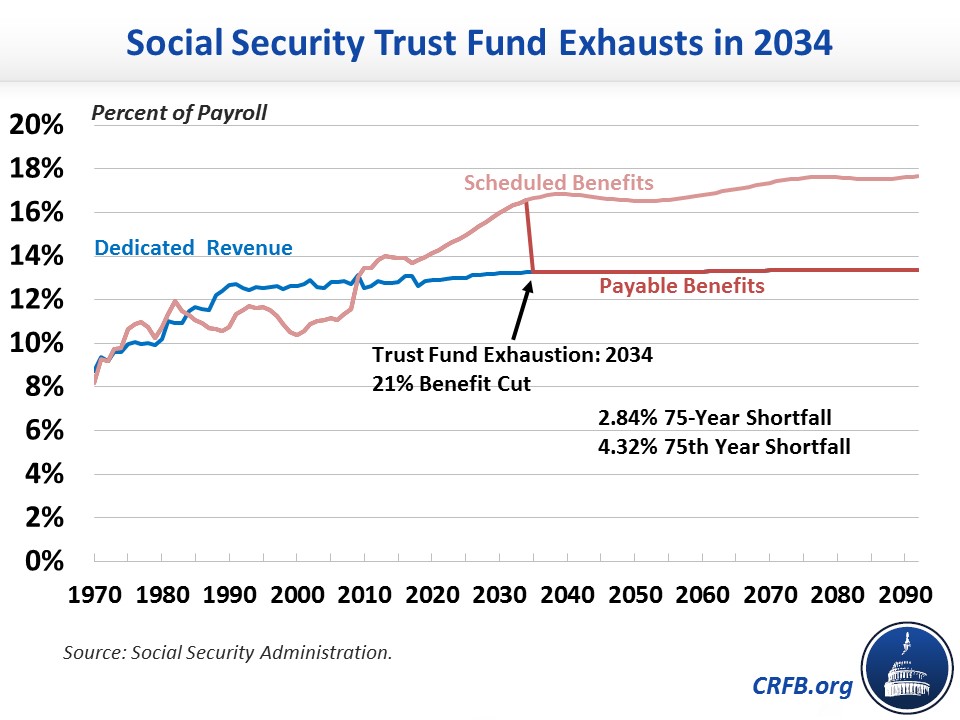A Quick Take on the 2018 Social Security and Medicare Trustees Reports
The Social Security and Medicare Trustees have released their reports on the financial state of the respective programs. Below is a quick take, and we'll have a full analysis later today and in the coming days.
The Trustees continue to show that the Social Security program is headed towards insolvency and faces a large and growing shortfall. They project that the Social Security Disability Insurance (SSDI) trust fund will run out in 2032, and the both the Old-Age and Survivors Insurance (OASI) and theoretical combined Social Security trust funds will run out in 2034. The report shows a very similar outlook as last year's report. Congress should act promptly to make changes to close the program's shortfall.
According to the Trustees, Social Security faces a 75-year shortfall of 2.84 percent of payroll (over 1 percent of GDP), which will grow to 4.32 percent of payroll by the 75th year. Maintaining solvency of 75 years will require the equivalent of immediately raising payroll taxes by nearly a quarter (from 12.4 percent to 15.2 percent), reducing all benefits by about one-sixth, reducing new benefits by over a fifth, or some combination. Sustaining solvency beyond then will mean ultimately raising the payroll tax by about one-third (to almost 17 percent) and reducing scheduled benefits by a quarter.

Social Security's deficits are the result of growing spending on benefits and flat revenue. Benefits have already grown from 10.4 percent of payroll in 2000 to 13.7 percent of payroll in 2017; they are projected to grow above 16.8 percent by 2040, level off for the next three decades, and then rise to 17.7 percent by 2092. Revenue will rise only slightly over the next 75 years, from 13.1 percent of payroll in 2017 to 13.4 percent by 2092.
Compared to the 2017 report, this year's report shows a 75-year shortfall that is about the same (2.84 percent of payroll versus 2.83 percent). This similar outlook is the net result of shifting the 75-year window from 2017-2091 to 2018-2092, which increases the shortfall by 0.06 percent, and other changes that reduce the shortfall by 0.05 percent. Most of the change is the net effect of incorporating new disability and demographic data and changes in projection methods. The Trustees also project that Social Security faces its first deficit (inclusive of interest) since the 1983 reforms – starting this year and continuing indefinitely through the projection period.
| Change in 75-Year Balance Since Last Year (Percent of Payroll) | |
|---|---|
| Effect on 75-Year Shortfall | |
| 2017 Report's 75-Year Shortfall | -2.83% |
| Legislation/Regulation | 0.00% |
| Change in Valuation Period | -0.06% |
| Demographic Data and Assumptions | -0.01% |
| Economic Data and Assumptions | -0.01% |
| Disability Data and Assumptions | +0.01% |
| Methods and Program Data | +0.05% |
| 2018 Report's 75-Year Shortfall | -2.84% |
Source: Social Security Administration. Note: Numbers do not sum due to rounding.
The Medicare Trustees' report estimates that the Hospital Insurance (Part A) trust fund will be exhausted in 2026, three years earlier than projected last year. Most of the changes between last year's report and this year's come in the short term; still, the projected 75-year shortfall increased from 0.64 percent of payroll last year to 0.82 percent of payroll. The change in the exhaustion date means that lawmakers have less than a decade to deal with Part A's shortfall. We will have more on the Medicare Trustees' report in the coming days.
With regards to Medicare on the whole (including Part B and D), the Trustees project total costs will rise from 3.7 percent of GDP in 2017 to 5.9 percent by 2042 and 6.2 percent by the 2092.
The latest Social Security and Medicare Trustees' reports makes the case for lawmakers moving quickly to enact Social Security changes that ensure the program's solvency for the next 75 years and beyond, while slowing the growth and improving financing of Medicare spending. With many baby boomers already in retirement and not too many years left until insolvency, time is running out to avoid drastic changes and make thoughtful reforms to the programs.


